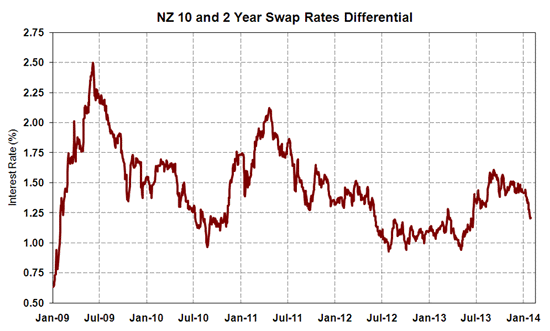
 By Roger J Kerr
By Roger J Kerr
The interest rate yield curve has been tweaked to a not as steep slope (i.e. flatter) over the past few weeks as the short-term money markets price a high probability (still 50/50) of earlier OCR increases this year.
However weaker US data and global investment market uncertainties have driven US 10-year treasury bond yields down from 3.00% to 2.72% - lowering our 10-year swap interest rates from a high of 5.30% to 5.00%.
In pricing-in more than 2.00% of increases in the OCR over the next two years, the local moneymarkets are concluding that the housing market will remain strong and inflation will increase as the exchange rate falls.
There is no guarantee that the housing market and NZD currency value will behave in line with the interest rate markets current expectations.
The only reason the NZ dollar would depreciate on its own account would be if wholemilk powder prices reversed sharply downwards and in that scenario the whole economic growth outlook would not look so good.
The NZD/USD and NZD/AUD exchange rates can move lower over the next six to 12 months, however the overall TWI value is likely to stay in the 75 to 78 range as the Yen, Euro and Pound weaken further against the USD than the Kiwi, sending these cross-rate higher.
The exchange rate plays a massive role in our economy, determining inflation with the very high import penetration and also determining GDP growth performance due to the dominance of export industries and their hiring and investment decisions.
It is why Governor Wheeler’s job is so difficult, as global currency market developments can stymie his best laid monetary policy management plans.
Despite some concerns that the local moneymarkets may have priced-in too much in the way of OCR increases already, it does not necessarily mean that two and three year swap interest rates will pull back downwards.
As more household borrowers fix their mortgage interest rates, the one-way market demand on the wholesale swap market from the banks off-laying their risk will ensure stable to marginally higher swap rates.
However long-term swap rates from three years on can still move substantially higher as they follow the US bond yields upwards.
The recent marginal flattening of the swap yield curve does not appear too sustainable.
Therefore, right now there are less points cost for corporate borrowers to re-fix maturing swaps over the next 18 months via forward stating swaps.
The flatter yield curve over the past month is evidenced by the 10-year/2-year swap differential reducing to 1.20% from 1.50%.
I do not see the flatter curve lasting too long.

-----------------------------------------------------------
To subscribe to our daily Currency Rate Sheet email, enter your email address here.
No chart with that title exists.
Roger J Kerr is a partner at PwC. He specialises in fixed interest securities and is a commentator on economics and markets. More commentary and useful information on fixed interest investing can be found at rogeradvice.com

We welcome your comments below. If you are not already registered, please register to comment.
Remember we welcome robust, respectful and insightful debate. We don't welcome abusive or defamatory comments and will de-register those repeatedly making such comments. Our current comment policy is here.